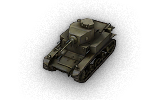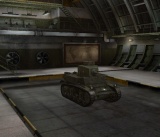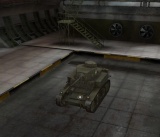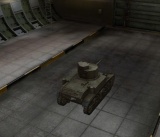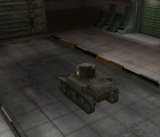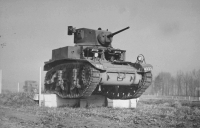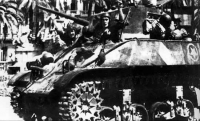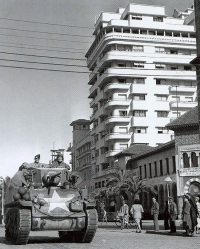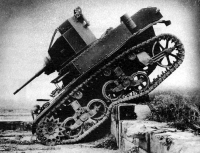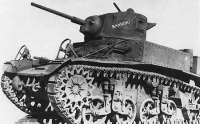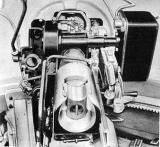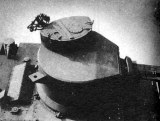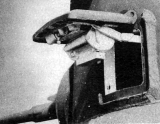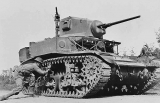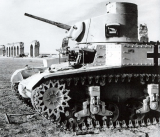M3 Stuart
The M3 Stuart is an American tier 3 light tank. The tank has reasonable armor for its tier, and the upgraded 37mm guns are fast and accurate. However, when placed in higher-tier battles, it will face better armed and armored opposition. Speed and stealth are the keys to survival for Light tanks; the M3 excels in both. Upgrade your suspension and engine and keep your movements unpredictable as you exploit the enemy's flanks, or race to a good hiding spot and help out your artillery and snipers by spotting the enemy as they advance. Avoid long drawn-out, stand-still shooting matches; the 37mm has a very high rate of fire so you can afford a few misses while shooting on the move!
- The M3 Stuart leads to the M5 Stuart.
A03 M3 Stuart/ModulesA03 M3 Stuart/EquipmentA03 M3 Stuart/Consumables
Historical Info
The "M3 Stuart", formally "Light Tank M3", was an American light tank of World War II. It was supplied to the British and Commonwealth forces under the lend-lease program prior to the US entering the war and used thereafter by both US and Allied forces until the end of the war.
The name "General Stuart" or "Stuart" given by the British comes from the American Civil War Confederate General J.E.B. Stuart and was used for both the M3 and the derivative M5 Light Tank. In British service it also had the unofficial nickname of "Honey", after a tank driver remarked "She's a honey". To the United States Army, the tanks were officially known only as "Light Tank M3" and "Light Tank M5".
The "M3 Stuart" was the first US tank with an American crew to engage in tank versus tank combat during World War II.
Development
Observing events in Europe, American tank designers realized that the Light Tank M2 was becoming obsolete and set about improving it. The upgraded design, with thicker armor, modified suspension, and new gun recoil system was called "Light Tank M3". Production of the vehicle started in March 1941 and continued until October 1943. Like its direct predecessor, the M2A4, the M3 was armed with a 37 mm M5 gun and five .30-06 Browning M1919A4 machine guns: coaxial with the gun, on top of the turret in an M20 AA mount, in a ball mount in the right bow, and in the right and left hull sponsons.Internally, the radial engine was at the rear of the tank and the transmission to the driving sprockets was at the front. The prop shaft connecting the two ran through the middle of the fighting compartment. The radial engine compounded the problem by having it's crankshaft high off the hull bottom. When a turret floor was introduced, the crew had even less room. To relieve the demand for the radial airplane engines used in the M3, a new version was developed using twin Cadillac V-8 automobile engines and a Hydra-Matic transmission. Such installation produced a quieter, cooler and roomier variant, and it was easier to train with the automatic transmission. This new model was initially called "M4", but redesignated "M5" to avoid confusion with the "M4 Sherman[5]". It also featured a redesigned hull with sloped glacis plate and driver's hatches moved to the top. Although the main criticism from the units using it was that the Stuarts lacked firepower, the improved M5 series kept the same 37 mm gun. The M5 gradually replaced the M3 in production from 1942 and was, in turn, succeeded by the Light Tank M24 in 1944.
Combat history
War in North Africa and Europe
The British Army was the first to use the Light Tank M3 as the "General Stuart" in combat. From mid-November 1941 to the end of the year, about 170 Stuarts (in a total force of over 700 tanks) took part in Operation Crusader during the North Africa Campaign, with poor results. Although the high losses suffered by Stuart-equipped units during the operation had more to do with better tactics and training of the Afrika Korps than the apparent superiority of German armoured fighting vehicles used in the North African campaign, the operation revealed that the M3 had several technical faults. Mentioned in the British complaints were the 37 mm M5 gun and poor internal layout. The two-man turret crew was a significant weakness, and some British units tried to fight with three-man turret crews. The Stuart also had a limited range, which was a severe problem in the highly mobile desert warfare as units often outpaced their supplies and were stranded when they ran out of fuel. On the positive side, crews liked it's relatively high speed and mechanical reliability. The high reliability distinguished the Stuart from cruiser tanks of the period, in particular the Crusader, which composed a large portion of the British tank force in Africa up until 1942.
From the summer of 1942, when enough US medium tanks had been received, the British usually kept Stuarts out of tank-to-tank combat, using them primarily for reconnaissance. The turret was removed from some examples to save weight and improve speed and range. These became known as "Stuart Recce". Some others were converted to armored personnel carriers and were known as "Stuart Kangaroo", and some were converted command vehicles and known as "Stuart Command". M3s, M3A3s, and M5s continued in British service until the end of the war, but British units had a smaller proportion of these light tanks than US units. The other major Lend-Lease recipient of the M3, the Soviet Union, was even less happy with the tank, considering it undergunned, underarmored, likely to catch fire, and too sensitive to fuel quality. The narrow tracks were highly unsuited to operation in winter conditions, as they resulted in high ground pressures under which the tank sank into the snow. Further, the M3's radial aircraft engine required high-octane fuel, which complicated Soviet logistics as most of their tanks used diesel. However, the M3 was superior to early-war Soviet light tanks such as the T-60, which were often underpowered and possessed even lighter armament than the Stuart. In 1943, the Red Army tried out the M5 and decided that the upgraded design was not much better than the M3. Being less desperate than in 1941, the Soviets turned down an American offer to supply the M5. M3s continued in Red Army service at least until 1944.
War in the Far East - CBI and Pacific
The US Army initially deployed 108 Stuart light tanks to the Philippines in September 1941, equipping the US Army's 194th and 192nd Tank Battalions. The first US tank versus tank combat to occur in World War II, began on 22 December 1941, when a platoon of five M3s led by Lieutenant Ben R. Morin engaged Type 95 Ha-Go north of Damaris. LT Morin maneuvered his Stuart off the road, but took a direct hit while doing so, and his tank began to burn. The other four Stuarts were also hit, but managed to leave the field under their own power. LT Morin was wounded, and he and his crew were captured by the enemy. M3s of the 194th and 192nd Tank Battalions continued to skirmish with the 4th Tank Regiment's Type 95 Ha-Go light tanks as they continued their retreat down the Bataan Peninsula, with the last tank verses tank combat occurring on 7 April 1942.
Due to the naval nature of the Pacific campaign, steel for warship production took precedence over tanks for the Imperial Japanese Army (IJA), creating by default an IJA light tank which performed admirably in the jungle terrain of the South Pacific. By the same measure, although the US was not hampered by industrial restrictions, the US M3 light tank proved to be an effective armored vehicle for fighting in jungle environments. With the IJA's drive toward India within the China-Burma-India Theater of Operations (CBI), the United Kingdom hastily withdrew their 2nd Royal Tank Regiment and 7th Hussars Stuart tank units (which also contained some M2A4 light tanks[15]) from North Africa, and deployed them against the Japanese 14th Tank Regiment. By the time the Japanese had been stopped at Imphal, only one British Stuart remained operational. Upon the American entry into the war in 1941, it had began to supply China with AFVs including the M3 Stuarts, and later M4 Shermans, and M18 Hellcats which trickled in through Burma and formed part of the several well-equipped, well-trained armies that the Chinese Nationalists could deploy. These units were responsible for stopping numerous Japanese attacks during the later phases of the war. Although the US light tanks had proven effective in jungle warfare, by late 1943, US Marine Corps tank battalions were transitioning their M3/M5 light tanks to M4 medium tanks. For the IJA, even though the US Marines had exchanged their light tanks for M4 medium tanks, they could not; and with the less common supplement of their Type 97 Chi-Ha medium tanks, the IJA was left to do battle against US Marine M4 Sherman medium tanks, with armor that had been designed and fielded in the 1930s.
Overview
When the US Army joined the North African Campaign in late 1942, Stuart units still formed a large part of it's armor strength. After the disastrous Battle of the Kasserine Pass, the US quickly followed the British in disbanding most of their light tank battalions and subordinating the Stuarts to medium tank battalions performing the traditional cavalry missions of scouting and screening. For the rest of the war, most US tank battalions had three companies of M4 Shermans and one company of M3s or M5/M5A1s. In Europe, Allied light tanks had to be given cavalry and infantry fire support roles since their main cannon armament could not compete with heavier enemy AFVs. However, the Stuart was still effective in combat in the Pacific Theater, as Japanese tanks were both relatively rare and were lighter in armor than even Allied light tanks. Japanese infantrymen were not well equipped with anti-tank weapons, and as such, had to use close assault tactics. In this environment, the Stuart was only moderately more vulnerable than medium tanks. In addition, the poor terrain and roads common to the theatre were unsuitable for the much heavier M4 medium tanks, and so initially, for both sides, it was advantageous to deploy light armor. Heavier M4s were eventually brought to overcome heavily entrenched positions, though the Stuart continued to serve in a combat capacity until the end of the war. Though the Stuart was to be completely replaced by the newer M24 Chaffee, the number of M3s/M5s produced was so great (over 25,000 including the 75 mm HMC M8) that the tank remained in service until the end of the war and well after. In addition to the United States, United Kingdom and Soviet Union, who were the primary users, it was also used by France, China (M3A3s and, immediately post-war, M5A1s) and Josip Broz Tito's Partisans in Yugoslavia (M3A3s and few M3A1). After the war, some countries chose to equip their armies with cheap and reliable Stuarts. The Republic of China Army, having suffered great attrition as a result of the ensuing civil war, rebuilt their armored forces by acquiring surplus vehicles left behind in the area by the US forces, including 22 M5A1s to equip two tank companies. They would have their finest hours during the Battle of Kuningtou, for which the tank came to be known as the "Bear of Kinmen".
The M5 played a significant role in the First Kashmir War (1947) between India and Pakistan. Most notably at the battle of Zoji-la Pass, which was fought at an elevation of nearly 12,000 feet. The vehicle remained in service in several South American countries until at least 1996. During the 1960s and 1970s, the Portuguese Army also used the M5 in the war in Angola, where its all terrain capability (compared to wheeled vehicles) was greatly appreciated. In 1967, The Portuguese Army deployed three M5A1 Light Tanks – nicknamed ‘Milocas’, ‘Licas’ and ‘Gina’ by their crews – in northern Angola, which served with the 1927th Cavalry Battalion stationed at Nambuangongo. The vehicles were employed mostly for convoy escort and recovery duties, and limited counter-insurgency operations against FNLA guerrillas, who dubbed them “Elefante Dundum”. ‘Milocas’ was destroyed by an accidental fire in 1969 whilst ‘Gina’ and ‘Licas’ were withdrawn from active service in 1972, the former being sent to Luanda and the latter ended up in 1973 as an airfield security pillbox in the Portuguese Air Force’ Zala airfield. Period photographs show some modifications in the basic design, namely the omission of the bow machine gun, re-installed on a pintle mount in the roof of the turret and a small searchlight fitted in front of the commander’s copula.
The M3 Stuart is still on the active list in the Armed Forces of Paraguay where those elderly survivors are the only tracked armor used by that country.
Hunnicutt, R. P. Stuart, A History of the American Light Tank. Vol. 1; 1992, Presidio Press. ISBN 0-89141-462-2. Zaloga, Steven. M3 & M5 Stuart Light Tank. 1999; Osprey New Vanguard 33. ISBN 978-1-85532-911-9. Zaloga, Steven. Japanese Tanks 1939-45. Osprey New Vanguard 137. ISBN 978-1-84603-091-8. Zaloga, Steven. Armored Thunderbolt, The US Army Sherman in World War II. 2008; Stackpole Books. ISBN 978-0-8117-0424-3.
Hembree, Mark. "History You Can Model" FineScale Modeler February 2011..Page 74 (ISSN 0277-979X, USPS No. 679-590)| Light Tanks | T1 Cunningham • M2 Light Tank • T1E6 • T2 Light Tank • T7 Combat Car • M22 Locust • M3 Stuart • MTLS-1G14 • M5 Stuart • M24 Chaffee • T21 • T71 |
| Medium Tanks | T2 Medium Tank • M2 Medium Tank • M3 Lee • M4 Sherman • M4A2E4 Sherman • M7 • Ram II • M4A3E2 Sherman Jumbo • M4A3E8 Sherman • T20 • M26 Pershing • T23 • T26E4 Super Pershing • T69 • M46 Patton • T54E1 • M48A1 Patton • M60 |
| Heavy Tanks | T1 Heavy Tank • T14 • M6 • T29 • M6A2E1 • T32 • T34 • M103 • T57 Heavy Tank • T110E5 |
| Tank Destroyers | T18 • T82 • M8A1 • T40 • M10 Wolverine • T49 • M18 Hellcat • M36 Jackson • T25 AT • T25/2 • T28 • T28 Prototype • T30 • T95 • T110E3 • T110E4 |
| Self-Propelled Guns | T57 • M7 Priest • M37 • M41 • M44 • M12 • M40/M43 • M53/M55 • T92
|
